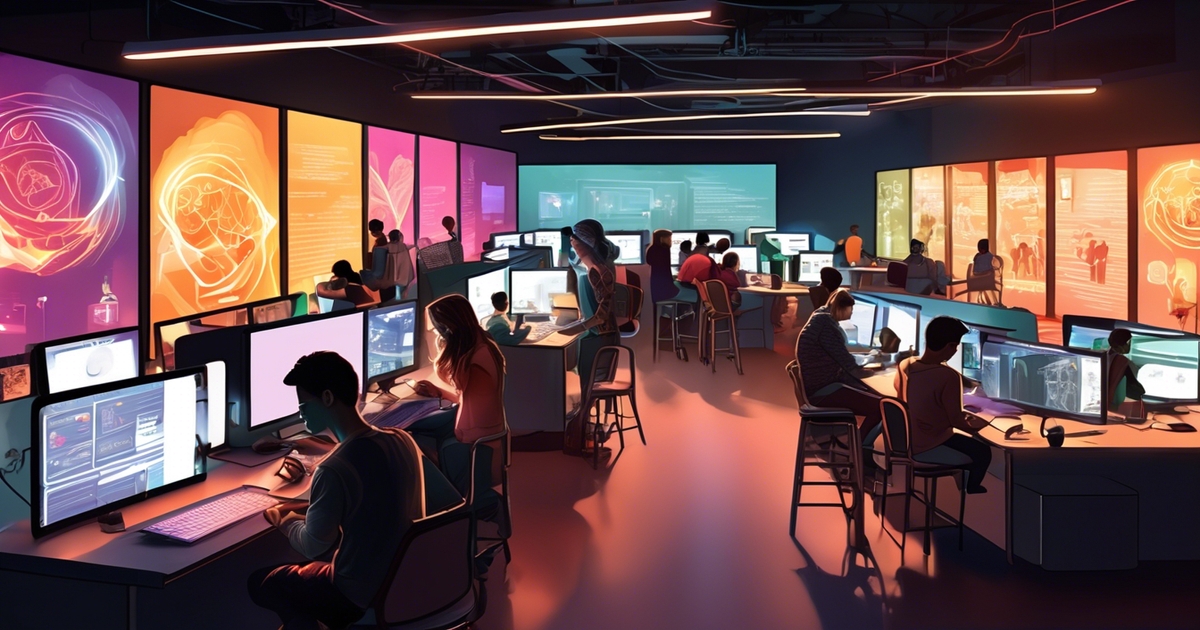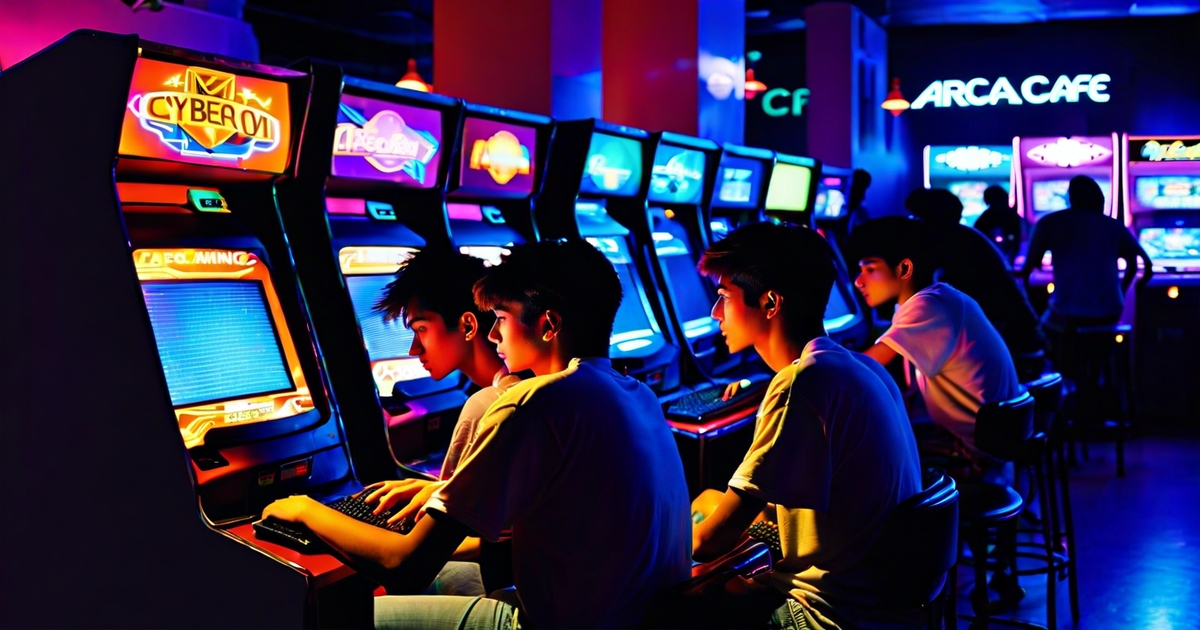What is a Cybercafe or Internet Cafe?

- Key Takeaways
- Defining the Modern Cybercafe
- Evolution and History of Cybercafes
- How Cybercafes Operate
- Services and Fees at Cybercafes
- Benefits of Using Cybercafes
- Ensuring Security and Privacy in Cybercafes
- The Role of Cybercafes in Digital Access
- Future Trends in Cybercafe Services
- Summary
- Frequently Asked Questions
Ever wondered about the modern version of a social hub where people connect over technology? Enter the cybercafe. This digital oasis offers high-speed internet, computer access, and often serves as a gaming haven.
But wait, there’s more! It’s not just about browsing or gaming; it’s also a place to grab a quick bite while multitasking on your devices. Join us as we delve into the world of cybercafes – their evolution, unique features, and their relevance in today’s tech-driven society.
Key Takeaways
- Understanding the modern cybercafe is essential for individuals seeking convenient access to the internet and digital services.
- Cybercafes have evolved over time to offer diverse services, catering to the changing needs of their users.
- When considering the use of cybercafes, it’s important to be aware of their operations, including the services offered and associated fees.
- Utilizing cybercafes can provide benefits such as access to technology, printing facilities, and a conducive environment for work or leisure activities.
- Prioritizing security and privacy measures while using cybercafes is crucial to safeguard personal information and prevent unauthorized access.
- Cybercafes play a significant role in providing digital access to individuals who may not have reliable internet connections, contributing to bridging the digital divide.
Defining the Modern Cybercafe

Services Offered
Cybercafes are modern establishments that provide internet access and various computer services. These facilities go beyond just offering internet access; they also provide amenities such as printing, scanning, and even gaming facilities. For example, patrons can use the computers to print documents or scan important papers.
Cybercafes cater to a diverse clientele, attracting people from all walks of life who require access to the internet and other computer services. The urban areas particularly host numerous cybercafes due to the high demand for these services in bustling city environments.
Popularity and Clientele
The popularity of cybercafes stems from their ability to offer affordable and convenient access to technology. People without personal computers or reliable internet connections at home often rely on cybercafes for tasks like job applications, online courses, or simply socializing on social media platforms.
Gamers frequent these establishments for multiplayer gaming experiences that may not be feasible on personal devices due to hardware requirements or network limitations. It’s common for young adults and teenagers to visit cybercafes after school hours or during weekends for gaming sessions with friends.
Evolution and History of Cybercafes

Origin in the 1990s
Cybercafes emerged in the 1990s to meet the growing need for internet access. During this time, not everyone had personal computers or internet connections at home. People relied on cybercafes to get online, check emails, and engage in basic web browsing. The concept gained popularity as it provided an affordable way for individuals to access the digital world.
The demand for internet access was a driving force behind the establishment of cybercafes. With limited availability of personal computers and internet connections at home, people turned to these public spaces to fulfill their digital needs.
Technological Advancements
As technology progressed, so did cybercafes. They evolved from being mere providers of internet access to offering more sophisticated services such as gaming facilities, video conferencing capabilities, printing services, and even food and beverages. These enhancements transformed cybercafes into versatile social hubs where people could not only browse the web but also engage in various leisure activities.
How Cybercafes Operate
Access and Usage
Cybercafes are establishments that provide access to computers with internet connectivity. Customers can use these computers on an hourly or per-minute basis, depending on the cybercafe’s policies. This allows individuals who do not have personal computers or internet access at home to go online for various purposes such as checking emails, browsing the web, or completing school assignments.
Some cybercafes also cater to gamers by offering high-end gaming PCs with fast internet connections. These establishments may charge different rates for gaming sessions compared to regular computer usage. Some cybercafes may impose restrictions on certain websites or content accessible from their computers to ensure a safe and appropriate environment for all users.
Additional Services
In addition to providing computer and internet access, many cybercafes offer additional services such as food and beverages. This creates a space where customers can relax, socialize, and enjoy refreshments while using the available technology. The availability of snacks and drinks makes it convenient for customers who may spend extended periods at the cybercafe working on projects or engaging in online activities.
Furthermore, some modern cybercafes have evolved into hybrid spaces that combine traditional cafe amenities with tech-related services like 3D printing stations, virtual reality experiences, or coding workshops. These innovative approaches aim to attract diverse customer demographics seeking both technological resources and social environments within a single establishment.
Services and Fees at Cybercafes
Common Services
Cybercafes offer a range of services to their customers, including internet browsing, document printing, and even gaming facilities. Customers can use the computers available at cybercafes to access the internet for various purposes such as checking emails, social networking, or online research. These establishments often provide printing services for individuals who need hard copies of documents or other materials. Some cybercafes also cater to gaming enthusiasts by offering computer setups with popular games installed.
Moreover, customers can make use of the space in cybercafes for tasks that require a quiet environment or when they need access to specific software not available on their personal devices. For instance, students might visit cybercafes to work on assignments using specialized software that is not accessible on their laptops.
Fee Structure
The fees at cybercafes are typically determined based on either the duration of usage or the specific services availed by customers. Customers may be charged per hour for using computing resources or have fixed rates for services like document printing. This flexible pricing model allows users to pay according to their individual needs and budget.
Furthermore, some cybercafes offer additional benefits through membership plans or loyalty programs aimed at frequent visitors. These programs often include discounts on regular usage fees or exclusive access to certain facilities within the establishment.
Benefits of Using Cybercafes
Convenient Access
Cybercafes play a crucial role in providing convenient access to the internet for individuals who do not own personal computers. For people who cannot afford their own devices or reliable internet connections, cybercafes offer an affordable and accessible alternative. This allows them to engage in various online activities such as research, communication, and entertainment without the need for expensive equipment.
Moreover, these establishments are particularly beneficial for travelers. When on the go, accessing the internet can be challenging. Cybercafes provide a solution by offering temporary access to online resources like checking emails, booking accommodations, or researching local attractions. This makes cybercafes valuable hubs for tourists seeking connectivity during their travels.
Social Environment
In addition to serving as access points to the digital world, cybercafes also offer a unique social environment for users. These spaces facilitate interaction and collaboration among individuals with shared interests. Whether it’s multiplayer gaming sessions or group study sessions, cybercafes bring people together in a physical space where they can engage in collective activities that require an online connection.
Furthermore, students and professionals often utilize cybercafes as meeting spots due to their relaxed atmosphere and availability of technology resources. It provides them with an informal setting outside traditional educational or work environments where they can brainstorm ideas or work on collaborative projects.
Ensuring Security and Privacy in Cybercafes
Implementing Security Measures
Cybercafes prioritize security by using antivirus software and firewalls to safeguard user data. These measures help prevent cyber-attacks that could compromise personal information. For example, antivirus software scans for and removes malicious programs, while firewalls act as barriers against unauthorized access.
To further enhance security, cybercafe operators regularly update their security systems to defend against the latest threats. This proactive approach ensures that users can browse the internet without fearing potential security breaches.
Exercising Caution
While cybercafes take steps to protect user data, customers should also exercise caution when accessing sensitive information in these public environments. It’s advisable not to input confidential details such as banking credentials or personal identification numbers (PINs) when using public computers at a cybercafe.
Users are encouraged to be mindful of their surroundings and ensure that no one is attempting to view their screen or steal sensitive information. By being vigilant and aware of potential risks, individuals can mitigate the chances of falling victim to privacy breaches.
The Role of Cybercafes in Digital Access
Bridging the Digital Divide
Cybercafes serve as vital hubs for digital access, particularly in areas with limited internet infrastructure. These establishments play a crucial role in providing affordable and accessible internet to communities that might otherwise struggle to connect online. By offering affordable internet access, cybercafes contribute significantly to bridging the digital divide. This means that underserved populations have the opportunity to engage in online learning, research, and job-related tasks.
In many regions around the world, students heavily rely on cybercafes for accessing educational resources and completing assignments. Professionals also frequent these establishments for various work-related tasks such as submitting job applications, attending virtual meetings, or conducting research. Without cybercafes, individuals within these communities would face significant barriers when trying to access information or participate in online activities due to limited connectivity options.
Community Impact
The impact of cybercafes extends beyond individual users; they also benefit entire communities by enabling widespread digital access. In addition to providing internet services, cybercafes often offer printing facilities and computer rentals at reasonable rates. This not only facilitates broader community engagement but also fosters economic growth by supporting small businesses and entrepreneurs who may not have their own office spaces or equipment.
Moreover, these establishments can act as social hubs where people gather not only for internet usage but also for social interactions and community engagement. For instance, individuals from different walks of life may come together at a local cybercafe to exchange ideas or collaborate on projects despite facing limitations posed by inadequate personal connectivity options.
Future Trends in Cybercafe Services

Integration of Advanced Technologies
Cybercafes are evolving, and the future may see them integrating virtual reality experiences and augmented reality applications. This means that patrons could have access to immersive gaming experiences or interactive educational content. For example, cybercafes might offer virtual reality simulations for customers to explore historical sites or participate in realistic training scenarios.
Advanced technologies like these can attract a new clientele and provide existing customers with unique experiences they cannot easily replicate at home. As a result, cybercafes will need to invest in cutting-edge equipment and software to stay competitive in this rapidly changing landscape.
Enhanced Cybersecurity Measures
As cybercafes expand their technological offerings, it becomes crucial for them to prioritize enhanced cybersecurity measures. With an increase in advanced technologies comes an increased risk of security breaches and data theft. To protect user information, cybercafes must implement robust security protocols such as encrypted networks, multi-factor authentication, and regular security updates.
Moreover, providing secure connections is essential for users engaging with sensitive activities such as online banking or accessing personal accounts on public computers. By prioritizing cybersecurity measures, cybercafes can build trust with their customers while safeguarding their privacy.
Summary
You’ve delved into the world of modern cybercafes, discovering their evolution, operations, services, benefits, and the crucial role they play in digital access. As technology continues to advance, cybercafes are adapting to meet the changing needs of their patrons. Ensuring security and privacy in these spaces is paramount, and as future trends in cybercafe services emerge, it’s essential to stay informed about how these establishments evolve to provide a safe and efficient digital environment.
Now that you understand the ins and outs of cybercafes, consider exploring one in your area. Experience firsthand the convenience and opportunities they offer for staying connected in a digitally driven world. Keep an eye on emerging trends and advancements in cybercafe services to make the most of what they have to offer. Stay curious, stay informed, and embrace the digital age!
Frequently Asked Questions
What is a cybercafe?
A cybercafe is a place where individuals can access the internet, use computers, and avail various digital services. It offers an alternative to having personal internet access at home.
How have cybercafes evolved over time?
Initially serving as basic internet browsing centers, modern cybercafes now provide advanced services like gaming, virtual reality experiences, and coworking spaces.
What are the typical services offered at cybercafes?
Cybercafes offer internet access, computer usage, printing facilities, and sometimes additional amenities such as snacks or beverages for purchase.
Are there any security risks associated with using cybercafes?
Yes. Users should be cautious about potential security threats in public networks. It’s advisable to avoid accessing sensitive information or using unsecured websites while in a cybercafe.
What role do cybercafes play in providing digital access to communities?
Cybercafes often serve as vital hubs for individuals who lack personal computing resources or reliable internet connections. They contribute significantly to bridging the digital divide.
